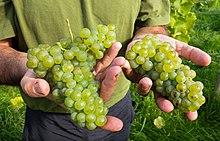
Maréchal Foch is an inter-specific hybrid French red wine grape variety. It was developed at the Oberlin Institute in Colmar-Alsace, at the beginning of the 20th century, then known as Kuhlmann 188-2, by Eugène Kuhlmann. The variety arrived in the U.S. in 1946, where it was subsequently renamed Marechal Foch in honor of Marshall Ferdinand Foch, Supreme Allied Commander during the First World War. Some believe it to be a cross of Goldriesling with a Vitis riparia - Vitis rupestris cross. Others contend that its pedigree is uncertain and may contain the grape variety Oberlin 595. It ripens early, is cold-hardy and resistant to fungal diseases. It is a teinturier, with pigmented juice as well as skins. The berry size is small, which makes it prone to bird injury. The quality of wine produced by Marechal Foch vines is highly dependent upon vine age, and the flavor profile associated with many new-world hybrid varietals is much reduced in examples made with fruit picked from older vines.

The Muscat family of grapes includes over 200 grape varieties belonging to the Vitis vinifera species that have been used in wine production and as raisin and table grapes around the globe for many centuries. Their colors range from white, to yellow, to pink to near black. Muscat grapes and wines almost always have a pronounced floral aroma. The breadth and number of varieties of Muscat suggest that it is perhaps the oldest domesticated grape variety, and there are theories that most families within the Vitis vinifera grape variety are descended from the Muscat variety.

Dornfelder is a dark-skinned variety of grape of German origin used for red wine. It was created by August Herold (1902–1973) at the grape breeding institute in Weinsberg in the Württemberg region in 1955. Herold crossed the grape varieties Helfensteiner and Heroldrebe, the latter which bears his name, to create Dornfelder. Helfensteiner and Heroldrebe were both crosses created some decades earlier by Herold. Dornfelder received varietal protection and was released for cultivation in 1979. It was named in honor of Immanuel August Ludwig Dornfeld (1796–1869), a senior civil servant who was instrumental in creating the viticultural school in Weinsberg.

Müller-Thurgau is a white grape variety which was created by Hermann Müller from the Swiss Canton of Thurgau in 1882 at the Geisenheim Grape Breeding Institute in Germany. It is a crossing of Riesling with Madeleine Royale. It is used to make white wine in Germany, Austria, Northern Italy, Hungary, England, Australia, the Czech Republic, Slovakia, Slovenia, New Zealand, Canada, the United States, Belgium and Japan. There are around 22,201 hectares ) cultivated worldwide, which makes Müller-Thurgau the most widely planted of the so-called "new breeds" of grape varieties created since the late 19th century. Although plantings have decreased significantly since the 1980s, as of 2019 it was still Germany's second most planted variety at 11,400 hectares and 11.4% of the total vineyard surface. In 2007, the 125th anniversary was celebrated at the Geisenheim Grape Breeding Institute. Müller-Thurgau is also known as Rivaner, Riesling x Sylvaner, Riesling-Sylvaner, Rizvanec (Slovenia) and Rizlingszilváni (Hungary).

Hybrid grapes are grape varieties that are the product of a crossing of two or more Vitis species. This is in contrast to crossings between grape varieties of the same species, typically Vitis vinifera, the European grapevine. Hybrid grapes are also referred to as inter-species crossings or "Modern Varieties." Due to their often excellent tolerance to powdery mildew, other fungal diseases, nematodes, and phylloxera, hybrid varieties have, to some extent, become a renewed focus for European breeding programs. The recently developed varieties are examples of newer hybrid grape varieties for European viticulturalists. Several North American breeding programs, such as those at Cornell and the University of Minnesota, focus exclusively on hybrid grapes, with active and successful programs, having created hundreds if not thousands of new varieties.

Regent is a dark-skinned inter-specific hybrid grape variety, used for making wine. It has both European and American vine species in its pedigree and a broad resistance against the most significant fungal diseases which affect grapes, such as downy mildew.

Rondo is a dark-skinned grape variety, used for making red wine. It is a hybrid grape or inter-specific crossing. It was created in 1964 by Professor Vilém Kraus in then-Czechoslovakia by crossing the varieties Zarya Severa and St. Laurent. He offered it to Dr. Helmut Becker (1927-1990) of the Geisenheim Grape Breeding Institute who conducted further work on it, which explains why the grape is known under a Geisenheim designation. The variety was first planted for research and later in bigger scale in the mid 1980s by Thomas Walk Vineyard in Ireland under the name Amurensis Walk; it was named Rondo in 1997.
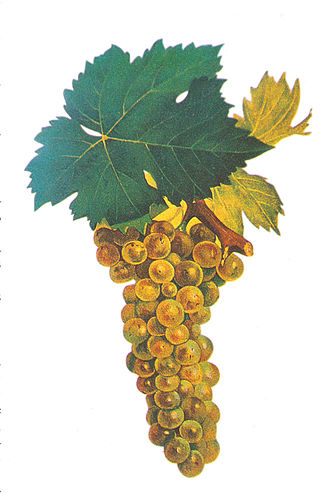
Muscat Blanc à Petits Grains is a white wine grape of Greek origin that is a member of the Muscat family of Vitis vinifera. Its name comes from its characteristic small berry size and tight clusters. It is known under a variety of local names such as Moscato bianco, Muscat blanc, Muscat Canelli, Muscat de Frontignan, Muscat de Lunel, Muscat d'Alsace, Muskateller, Moscatel de Grano Menudo, Moscatel rosé and Sárgamuskotály.
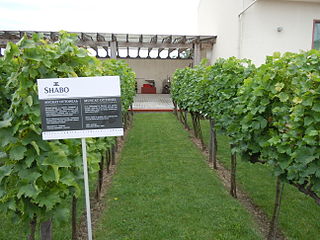
Muscat Ottonel or Muskat-Ottonel is a white wine grape variety that is a member of the Muscat family of Vitis vinifera. It is most notable for its use in dessert wines from Austria, Bulgaria, Romania, Moldova, Croatia and Serbia as well as dry wines from Alsace and Hungary. In Alsace, the varietal designation Muscat d'Alsace is allowed for the varieties Muscat Ottonel, Muscat blanc à petit grains and Muscat rose à petit grains blended in any combination -or not-, and blends between these are not allowed for most Alsace Grands Crus.
Couderc noir is a red wine hybrid grape that was formerly grown primarily in the South West France wine region and around the Gard département in the Languedoc-Roussillon region. The vine produces high yields and ripens late, creating a wine that is deeply colored with a distinct, earthy flavor. Couderc noir is normally used for mass commercial and table wines.

Siegerrebe is a white wine grape that is grown primarily in Germany with some plantings in England, Vancouver Island, Washington state, British Columbia's North Okanagan and Fraser Valley and Nova Scotia's Annapolis Valley along with a small planting in Tasmania, Australia at Every Man and His Dog Vineyard. Siegerrebe was created by German viticulturalist Dr. Georg Scheu (1879-1949) in 1929 at a grape-breeding institute in Alzey in Rheinhessen, by crossing Madeleine Angevine and Gewürztraminer. However, Georg Scheu's son Heinz Scheu has claimed in a book that Siegerrebe was the result of self-pollination of Madeleine Angevine. Siegerrebe received varietal protection and was released for general cultivation in Germany in 1958.
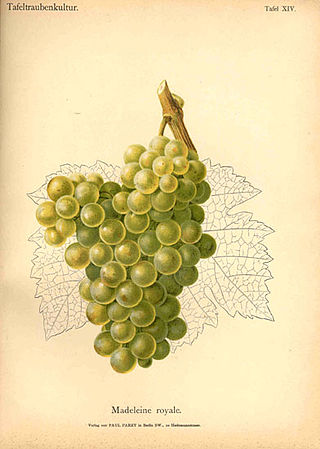
Madeleine Royale is a variety of white grape. It is mostly grown for table grapes or ornamental purposes, but is notable as a parent of Müller-Thurgau and Madeleine Angevine. It ripens extremely early, in some cases by the 22 July, the feast day of Mary Magdalene, hence the name.

Orléans is a variety of white grape which up until the 19th century was much grown in Germany, but in very little use since the early 20th century. It has large berries with thick skins and a high yield. Young Orléans wine has been described as somewhat reminiscent of wine made from white varieties of the pinot family, but with pineapple aromas.

Bronner is a white grape variety used for wine. It was bred in 1975 by Norbert Becker at the viticultural institute in Freiburg, Germany. The variety was initially known under its breeding code FR 250-75, and was later named in honour of Johann Philipp Bronner (1792-1864), who was a German pharmacist and viticultural pioneer. It received varietal protection in 1977.

Ehrenbreitsteiner is a white wine grape variety of German origin. It was created by Helmut Becker at the Geisenheim Grape Breeding Institute in 1964, by crossing the varieties Ehrenfelser and Reichensteiner. It was granted plant variety rights in 1993 and was certified in 1994.

Cabernet Cortis is a dark-skinned grape variety used for wine. It was bred in 1982 by Norbert Becker at the viticultural institute in Freiburg, Germany as part of a programme searching for disease-resistant grape varieties. It received German varietal protection in 2003.

Muscat bleu is a red Swiss wine and table grape variety that is a hybrid of Garnier 15-6 and Perle noire. The grape was developed in Peissy in the Canton of Geneva by Swiss grape breeder Charles Garnier in the 1930s. Today the grape is used as both a table grape and for winemaking, producing wines that Master of Wine Jancis Robinson describe as "soft and grapey". Outside Switzerland, some plantings of Muscat bleu can also be found in Belgium.
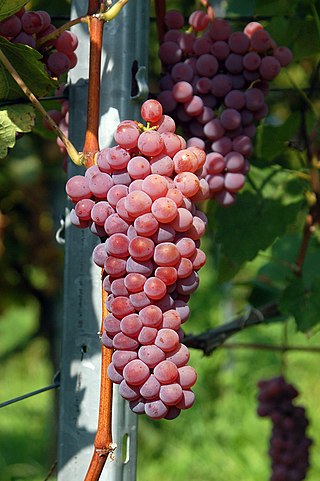
Souvignier gris is a white German wine grape variety that was created in 1983 by Dr. Norbert Becker. It is a cross between Seyval blanc and Zähringer, but was originally thought to be a cross between Cabernet Sauvignon and Bronner.
Zarya severa is a red grape variety. It is a descendant of the Asiatic wild grape Vitis amurensis and the grape Malingre Précoce of French origin and is thus a hybrid vine. The crossing took place at the Potapenko Viticulture Research Institute in Rostov Oblast, Russia in 1936. Because of its high winter frost resistance as well as its resistance to downy mildew, this variety, often mentioned by breeders in Eastern Europe, became a major breeding stock in the search for new varieties.
